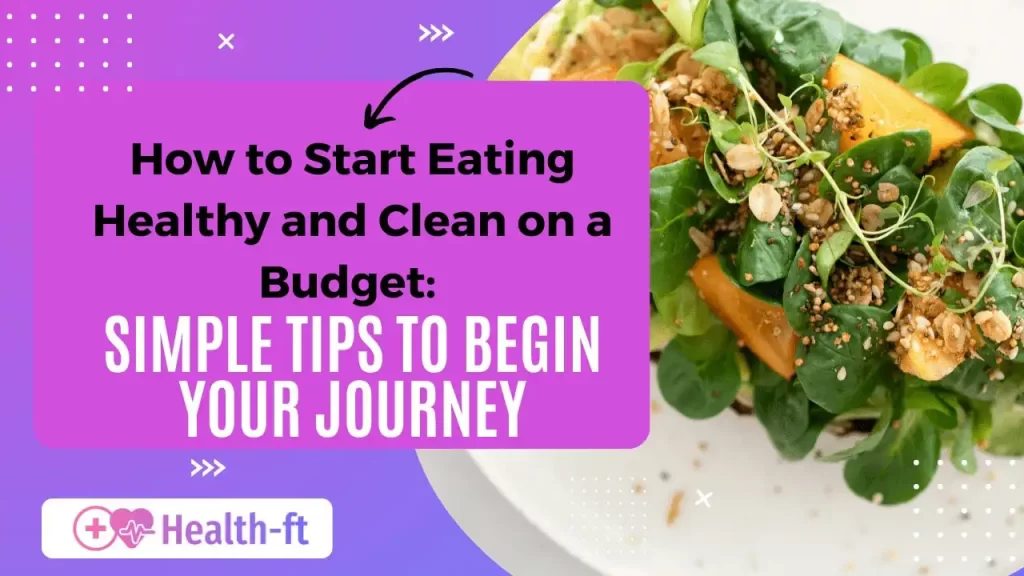It is often assumed that making healthy food choices will leave you with a bill as high as that of a luxury car, but the reality is quite different. If informed and strategic, you can start your journey toward clean and healthy eating without straining your budget. Whether you are new to clean eating or simply looking for how to eat healthy on a budget, this guide will help you begin.
By the end of this guide, you will have a clear understanding of how to plan balanced meals that won’t break the bank when buying groceries or cooking at home.
What Is the Meaning Behind Eating Healthy and Clean?
To start, it’s important to understand what “eating healthy and clean” actually means. Healthy eating means consuming meals that provide your body with the necessary nutrients in proper proportions, helping you achieve the benefits of eating healthy, such as increased energy and better overall health.
A healthy gut diet plan of foods rich in fiber and probiotics is crucial for a healthy. Whole grains, lean proteins, and fermented foods like yogurt can enhance digestion and support gut health.
Healthy Eating
Incorporating foods that support specific areas of health is a key part of a balanced diet. For instance, liver healing foods such as leafy greens, garlic, and cruciferous vegetables are excellent for detoxifying the body. Including these in your diet will support your liver function and overall well-being.
- Fruits and Vegetables: These are free from cholesterol and fat, providing necessary vitamins, minerals, and fiber.
- Whole Grains: Brown rice, quinoa, and whole wheat are nutrient-dense and fiber-rich.
- Lean Proteins: Sources like chicken, turkey, fish, beans, and legumes help repair tissues and build muscle.
- Healthy Fats: Avocados, nuts, seeds, and olive oil support brain health and hormone balance.
- Limited Sugars and Processed Foods: A healthy diet minimizes the consumption of refined sugars, unhealthy fats, and artificial additives.
Clean Eating
Clean eating focuses on consuming whole, unprocessed foods. It avoids artificial additives or preservatives that can reduce the nutritional value of food. Clean eating typically includes:
- Whole, Unprocessed Foods: Fresh fruits, non-starchy vegetables, whole grains, and lean meats.
- Avoiding Artificial Additives: Foods free from artificial colors, flavors, and preservatives.
- Cooking at Home: Preparing meals from scratch to maintain control over ingredients.
- Eating Organic or Locally Sourced Foods: Opting for organic and seasonal produce to lower exposure to pesticides and support local agriculture.
By combining these two approaches, you can develop a nutrition plan that nourishes your body while reducing intake of harmful substances found in processed foods.
How to Start Eating Healthy?
Eating healthy can be easy when you have a plan. Incorporate affordable, nutrient-rich foods into your meal plan for healthy eating, such as:
Evaluate Your Current Eating Habits
Start by reviewing your current eating practices. Take note of your daily meals and snacks, and ask yourself:
- Do you eat enough fruits and vegetables each day?
- Do you often rely on processed or fast food?
- How frequently do you prepare meals at home?
- Are you consuming sugary drinks instead of water?
Understanding where you currently stand will help identify areas for improvement.
Set Clear and Realistic Goals
After evaluating your current diet, set achievable goals. Rather than overhauling your diet immediately, aim for small, realistic changes. For example:
- Increase Your Vegetable Intake: Commit to adding at least three servings of vegetables per day.
- Reduce Sugary Drinks: Replace sugary sodas with water or herbal tea.
- Limit Processed Foods: Start by swapping one processed meal or snack each day for a whole-food alternative.
Breaking goals into smaller steps will help keep you motivated and allow for better tracking of progress.
Incorporate More Whole Foods
A simple way to start eating healthier is to include more whole foods in your diet. Whole foods are minimally processed and contain fewer additives. Begin by:
- Eating More Fruits and Vegetables: Fresh, frozen, or canned in water/juice are all good options.
- Switching to Whole Grains: Choose brown rice, quinoa, and whole wheat instead of white bread and pasta.
- Choosing Lean Proteins: Opt for chicken, turkey, fish, beans, and lentils.
Incorporating more whole foods will naturally reduce your intake of processed foods.
Plan Your Meals Ahead
Meal planning is essential for healthy lifestyle habits. By planning meals in advance, you avoid resorting to unhealthy fast foods. Meal planning also helps reduce impulse buying at the store.
More tips for meal planning and preparation will be covered in later sections, but it’s important to approach meal planning gradually and build a sustainable routine.
How to Afford Healthy Eating While Staying Within a Budget?
Eating healthy doesn’t have to be expensive. Here are some practical tips for maintaining a healthy diet on a budget:
Develop a Shopping List and Stick to It
A grocery list helps prevent impulse buying, which can quickly add up, especially with processed foods. Here’s how to create an effective list:
- Plan meals for the week ahead and only buy what you need.
- Avoid shopping when you’re hungry to prevent unnecessary purchases.
- Stick to the store’s outer aisles, where fresh produce, meats, and whole grains are typically located.
Buy in Bulk
Buying in bulk can help reduce costs for staple items. Some budget-friendly bulk purchases include:
- Brown rice, quinoa, and oats
- Dry beans and lentils
- Frozen vegetables and fruits
- Whole grain pasta and flour
Bulk items often have a longer shelf life, making them ideal for meal planning. Be sure to store them properly to avoid spoilage.
Choose Seasonal and Local Produce
Seasonal produce is often cheaper and more nutritious since it doesn’t have to be transported over long distances. Some examples include:
- Fall: Apples, squash
- Winter: Leafy greens, citrus
- Spring: Strawberries, asparagus
- Summer: Tomatoes, peppers, corn
Buying seasonal produce supports local farmers and keeps your grocery bill down.
Cook at Home More Often
Cooking at home is more cost-effective than eating out. It also allows you to control what goes into your food. Start with simple recipes like:
- Vegetable and brown rice stir-fries
- Lentil or bean stews and soups
- Fresh salads with lean proteins and whole grains
Preparing meals in larger quantities allows you to use leftovers, stretching your food budget further.
Limit Processed Foods
Processed foods may seem convenient, but they are often more expensive and less nutritious. Instead of buying pre-packaged snacks, consider making your own:
- Homemade granola bars or energy bites
- Air-popped popcorn with sea salt
- Veggie sticks with hummus
- Fresh fruit or nuts
By reducing processed foods, you can save money and improve your diet.
How to Eat Healthy on a Budget? A Simple Guide to Eating Healthy
One of the keys to eating healthy on a budget is meal planning. Here’s a simple healthy food diet chart table that shows healthy foods to eat everyday breakfast, lunch, and dinner affordably:
| Meal Type | Affordable Options | Tips |
|---|---|---|
| Breakfast | Oatmeal, scrambled eggs, smoothies (with frozen fruits) | Buy bulk oats and frozen berries. |
| Lunch | Lentil soup, quinoa salad, bean wraps | Buy beans in bulk and use seasonal veggies. |
| Dinner | Stir-fries, pasta with vegetables, rice bowls | Use frozen veggies and bulk rice for cost-effective meals. |
| Snacks | Hummus with veggie sticks, homemade granola bars | Make granola bars in batches for the week. |
| Protein | Tofu, chicken thighs, beans, lentils | Buy bulk protein sources and freeze portions for later. |
This approach will not only save money but also ensure you get the nutrition you need without the added expense of processed foods or takeout meals.
How to Eat Clean: A Simple Guide
Eating clean focuses on whole, unrefined foods. Here’s how to get started:
Focus on Whole, Unprocessed Foods
Clean eating is all about sticking to foods that are as close to their natural state as possible. These include:
- Fresh fruits and vegetables
- Whole grains like brown rice, quinoa, and oats
- Lean proteins such as chicken, fish, and legumes
- Healthy fats from avocados, olive oil, and nuts
Staying within these food groups helps you avoid processed ingredients.
Read Labels Carefully
When shopping for packaged foods, pay attention to the labels. Choose products with few ingredients, and avoid foods with artificial additives, preservatives, or added sugars.
Cook from Scratch
Cooking from scratch allows you to control exactly what goes into your meals. Try simple recipes that rely on whole, minimally processed ingredients. As you gain confidence, you can experiment with more complex dishes.
Get Ready for Success through Meal Planning and Preparation
Meal planning is key for staying on track and managing your food budget. Here’s how:
Plan Your Meals for the Week
Pick a time each week to plan your meals and snacks. This helps you stay organized, reduce food waste, and shop more efficiently. Look for meals that share ingredients to save money.
Prep Ingredients in Bulk
Preparing ingredients ahead of time saves you time and provides healthy options throughout the week. Cook large batches of grains, roast vegetables, or grill proteins to use in various meals.
Use Leftovers Wisely
Don’t let leftovers go to waste. Repurpose them into new dishes like frittatas, wraps, or soups to stretch your budget even further.
Conclusion
The process of how to eat healthy on a budget commences with little, achievable adjustments. Concentrating on whole foods, creating your meal plans, and making wise shopping decisions enables you to enjoy a healthy diet without draining your wallet. The critical step is to highlight fresh and simply processed ingredients, cook meals at home, and organize in advance.
These pieces of advice help you to achieve your health ambitions. Achieving a healthy and clean eating plan on a budget is completely possible and also very rewarding, as you both fuel your body and mind your money.




